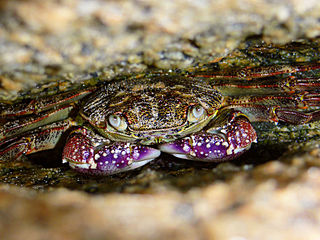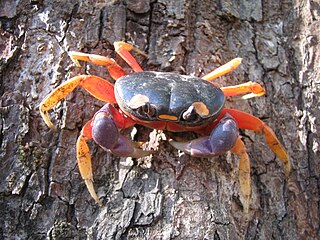
Malacostraca is the second largest of the six classes of pancrustaceans behind insects, containing about 40,000 living species, divided among 16 orders. Its members, the malacostracans, display a great diversity of body forms and include crabs, lobsters, crayfish, shrimp, krill, prawns, woodlice, amphipods, mantis shrimp, tongue-eating lice and many other less familiar animals. They are abundant in all marine environments and have colonised freshwater and terrestrial habitats. They are segmented animals, united by a common body plan comprising 20 body segments, and divided into a head, thorax, and abdomen.

Porcelain crabs are decapod crustaceans in the widespread family Porcellanidae, which superficially resemble true crabs. They have flattened bodies as an adaptation for living in rock crevices. They are delicate, readily losing limbs when attacked, and use their large claws for maintaining territories. They first appeared in the Tithonian age of the Late Jurassic epoch, 145–152 million years ago.

Ocypode is a genus of ghost crabs found in the sandy shores of tropical and subtropical regions throughout the world. They have a box-like body, thick and elongated eyestalks, and one claw is larger than the other in both males and females. They inhabit deep burrows in the intertidal zone. They are primarily nocturnal, and are generalist scavengers and predators of small animals. The genus contains 21 species.

Leptograpsus variegatus, known as the purple rock crab, is a marine large-eyed crab of the family Grapsidae, found in southern subtropical Indo-Pacific Oceans. It grows to around 50 millimetres (2.0 in) shell width. It is the only species in the genus Leptograpsus.

Charybdis is a genus of swimming crabs in the family Portunidae. It is named after the monster Charybdis of Greek mythology.

Gecarcinus is the type genus of the land crab family Gecarcinidae. They are found in warmer coastal regions of the Americas, including islands in the Caribbean. Four species from oceanic islands were formerly included in Gecarcinus as the subgenus Johngarthia, but are now treated as a separate genus, Johngarthia. While all members of this genus are largely terrestrial, they have to return to the ocean to breed. They are often colourful, with reddish, orange, purple, yellowish, whitish, or blackish being the dominating hues. This has resulted in some species, notably G. quadratus and G. lateralis, gaining a level of popularity in the pet trade.

Cancer bellianus, the toothed rock crab, is a common species of crab in the north-eastern Atlantic Ocean.

Percnon gibbesi is a species of crab. It is one of at least two species commonly called Sally Lightfoot, and is also referred to as the nimble spray crab or urchin crab. It has been described as "the most invasive decapod species to enter the Mediterranean".

Dardanus pedunculatus, commonly referred to as the anemone hermit crab, is a species of hermit crab from the Indo-Pacific region. It lives at depths of up to 27 m and collects sea anemones to place on its shell for defence.

Tumidodromia dormia, the sleepy sponge crab or common sponge crab, is the largest species of sponge crab and the only species in the genus Tumidodromia. It grows to a carapace width of 20 cm (8 in) and lives in shallow waters across the Indo-Pacific region.

Inachus phalangium, or Leach's spider crab, is a species of crabs from the north-eastern Atlantic Ocean and Mediterranean Sea. It is up to 20.5 mm (0.81 in) wide, and is very similar to other species in the genus Inachus.

Leucosiidae is a family of crabs containing three subfamilies and a number of genera incertae sedis:

Neolithodes is a genus of king crabs in the subfamily Lithodinae. They are found in all major oceans, both in high and low latitudes. Although there are records from water as shallow as 70 m (230 ft) in cold regions, most records are much deeper, typically 700–2,000 m (2,300–6,600 ft), with the deepest confirmed at 5,238 m (17,185 ft). They are fairly large to large crabs that typically are reddish in color and spiny, although the size of these spines varies depending on species.

Polybius henslowii is a species of crab, the only species in the genus Polybius. It is a capable swimmer and feeds in open water in the north-east Atlantic Ocean and western Mediterranean Sea.

Hyas coarctatus is a marine crab species native to the North Atlantic. It is characterized by a lyriformed shell.

Myra is a genus of crabs in the family Leucosiidae.
Ixa is a genus of Indo-Pacific pebble crabs from the family Leucosiidae. The genus was erected by William Elford Leach in 1816. One species, the Red Sea pebble crab, is a Lessepsian migrant and the species was first described to science from specimens collected on the Mediterranean Sea although the species is native to the Red Sea and had colonised the eastern Mediterranean through the Suez Canal.
Charybdis longicollis, the lesser swimming crab, is a species of crab from the swimming crab family, the Portunidae. It has a native range which covers the north-western Indian Ocean and it has invaded the Mediterranean Sea by Lessepsian migration through the Suez Canal.
Neolithodes capensis is a species of king crab which is found in the Southern Ocean and the western Indian Ocean. It has been found to a depth of 660–3,200 metres (2,170–10,500 ft). They have been found near Cape Point and around the Crozet and Kerguelen Islands in the subantarctic, and they are widespread in the Bellingshausen Sea on the Antarctic continental slope.
Paralomis dawsoni is a species of king crab which lives in New Caledonia, northern New Zealand, and the Solomon Islands at depths of 400–1,118 m (1,312–3,668 ft). Alongside P. zealandica, it is one of the two most common species of Paralomis in New Zealand. As of 2023, the Department of Conservation in New Zealand classifies P. dawsoni as "Naturally Uncommon".

















